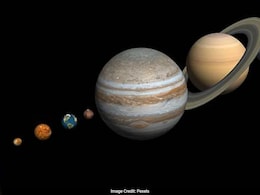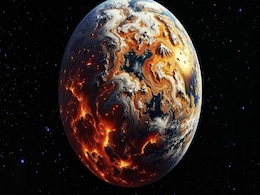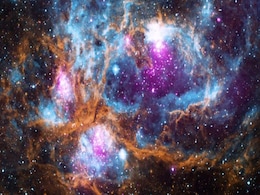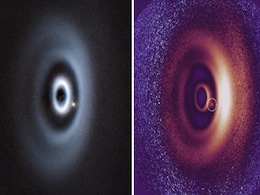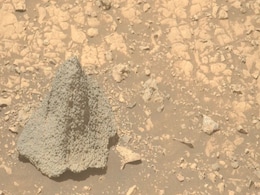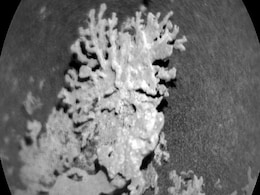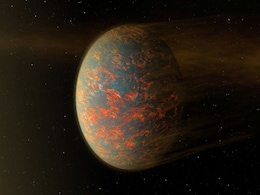Planet Formation
- All
- News
-

New Study Challenges Long-Held Beliefs About Formation Of The Moon
- Monday November 24, 2025
- Science | Edited by Astitva Raj
According to researchers, the composition of a planet or celestial body holds the entire story of its formation and origin.
-
 www.ndtv.com
www.ndtv.com
-

Astronomers Spot Possible Primordial Cluster Beyond Neptune
- Sunday November 23, 2025
- Science | Edited by Astitva Raj
According to Princeton researchers, the classical belt's structure should be understood as consisting of three major components.
-
 www.ndtv.com
www.ndtv.com
-

Planets Could Create Their Own Water While Forming, Expanding Possibilities for Habitable Worlds
- Tuesday November 11, 2025
- Written by Gadgets 360 Staff
Lab experiments show planets can generate water during formation, not just via comets. This suggests habitable conditions may be widespread in the galaxy, expanding possibilities for life-friendly exoplanets.
-
 www.gadgets360.com
www.gadgets360.com
-

NASA’s ESCAPADE Mission Will Send Twin Probes to Uncover Mars’s Atmospheric Secrets
- Monday November 10, 2025
- Written by Gadgets 360 Staff
NASA’s ESCAPADE mission will launch twin mini-satellites, Blue and Gold, to Mars aboard Blue Origin’s New Glenn. The probes will study how solar wind stripped away Mars’s atmosphere and water, helping scientists understand the Red Planet’s lost climate and its transformation into the dry world we see today.
-
 www.gadgets360.com
www.gadgets360.com
-

NASA's James Webb Space Telescope Telescope Challenges Old Theories on Mini-Neptune Worlds
- Friday November 7, 2025
- Written by Gadgets 360 Staff
New models suggest mini-Neptunes—planets smaller than Neptune with thick gas envelopes—may have solid rocky surfaces instead of molten magma. Data from NASA’s JWST revealed high-pressure atmospheres capable of compressing molten rock into solid crusts. This discovery challenges earlier assumptions and offers key insights into exoplanet compos...
-
 www.gadgets360.com
www.gadgets360.com
-

Astronomers Stunned As Rogue Planet Grows At Record Speed
- Monday November 3, 2025
- Science | Edited by Astitva Raj
The object, known as Cha 1107-7626, lies about 620 light-years away and is estimated to be five to ten times the mass of Jupiter.
-
 www.ndtv.com
www.ndtv.com
-

MIT Detects Traces of a Lost ‘Proto Earth’ Deep Beneath Our Planet’s Surface
- Monday October 20, 2025
- Written by Gadgets 360 Staff
MIT researchers have discovered rare isotopic traces of a “proto Earth” that existed before the giant impact that shaped our modern planet. Found deep in ancient rocks, these potassium isotope signatures reveal remnants of Earth’s earliest material, offering fresh insight into the planet’s formation and the solar system’s earliest history...
-
 www.gadgets360.com
www.gadgets360.com
-

Astronomers Capture First-Ever Image Of A Baby Planet Forming In Real Time
- Tuesday October 7, 2025
- Science | Edited by Nikhil Pandey
Astronomers have made a groundbreaking discovery by directly observing a young protoplanet, WISPIT 2b, embedded in a ring-shaped gap in a disk around a young star.
-
 www.ndtv.com
www.ndtv.com
-

James Webb Spots Bizarre Planet-Forming Disk Full of Carbon Dioxide
- Friday September 5, 2025
- Written by Gadgets 360 Staff
The James Webb Space Telescope has spotted a bizarre planet-forming disk dominated by carbon dioxide where water is almost absent. This rare finding, in star system XUE 10 within NGC 6357, challenges current models of planetary formation and may reshape our understanding of habitable worlds.
-
 www.gadgets360.com
www.gadgets360.com
-

Breakthrough Photo: See The 'Birth' Of A Planet For The Very First Time
- Friday August 29, 2025
- Science | Edited by Nikhil Pandey
A team of astronomers has detected for the first time a planet outside our solar system, embedded in a cleared gap of a multi-ringed disc.
-
 www.ndtv.com
www.ndtv.com
-

A Planet Is Being Born: Astronomers Capture Rare Cosmic Snapshot
- Saturday August 30, 2025
- Written by Gadgets 360 Staff
Astronomers have captured a groundbreaking sight: WISPIT 2b, a baby gas giant planet forming within a dusty, multi-ring protoplanetary disk around a young Sun-like star 430 light-years away. Infrared images from the Very Large Telescope show the planet carving a dark path in the rings as it feeds on gas and dust. This rare discovery provides the fi...
-
 www.gadgets360.com
www.gadgets360.com
-

NASA’s Perseverance Rover Spots Helmet-Like Rock on Mars, Sparks Geology Debate
- Saturday August 30, 2025
- Written by Gadgets 360 Staff
NASA’s Perseverance rover has photographed a helmet-shaped rock on Mars. Nicknamed “Horneflya,” the unusual spherule-covered formation intrigues scientists exploring how water, volcanic activity, or chemical processes shaped the Martian surface. Captured by Mastcam-Z, the discovery adds to Perseverance’s catalogue of strange formations and ...
-
 www.gadgets360.com
www.gadgets360.com
-

NASA’s Curiosity Rover Spots Ancient Coral-Like Rock on Mars
- Tuesday August 12, 2025
- Written by Gadgets 360 Staff
On July 24, 2025, NASA’s Curiosity Mars rover captured an image of a small, coral-shaped rock in Gale Crater using its ChemCam Remote Micro Imager. The light-colored, 1-inch (2.5 cm) formation likely formed billions of years ago when mineral-rich water seeped into tiny fractures in the rock, leaving behind hardened mineral veins after evaporation...
-
 www.gadgets360.com
www.gadgets360.com
-

NASA Missions Uncover a Diverse Galaxy of Super-Earths, Raising New Questions About Planetary Evolution
- Thursday August 14, 2025
- Written by Gadgets 360 Staff
Super-Earths are among the most common planets in the galaxy, yet none exist in our solar system. Larger than Earth but smaller than Neptune, they range from ocean-covered worlds to scorched, atmosphere-less rocks. Some orbit within habitable zones, making them prime candidates for life. NASA’s Kepler and TESS missions, along with upcoming telesc...
-
 www.gadgets360.com
www.gadgets360.com
-

New Study Challenges Long-Held Beliefs About Formation Of The Moon
- Monday November 24, 2025
- Science | Edited by Astitva Raj
According to researchers, the composition of a planet or celestial body holds the entire story of its formation and origin.
-
 www.ndtv.com
www.ndtv.com
-

Astronomers Spot Possible Primordial Cluster Beyond Neptune
- Sunday November 23, 2025
- Science | Edited by Astitva Raj
According to Princeton researchers, the classical belt's structure should be understood as consisting of three major components.
-
 www.ndtv.com
www.ndtv.com
-

Planets Could Create Their Own Water While Forming, Expanding Possibilities for Habitable Worlds
- Tuesday November 11, 2025
- Written by Gadgets 360 Staff
Lab experiments show planets can generate water during formation, not just via comets. This suggests habitable conditions may be widespread in the galaxy, expanding possibilities for life-friendly exoplanets.
-
 www.gadgets360.com
www.gadgets360.com
-

NASA’s ESCAPADE Mission Will Send Twin Probes to Uncover Mars’s Atmospheric Secrets
- Monday November 10, 2025
- Written by Gadgets 360 Staff
NASA’s ESCAPADE mission will launch twin mini-satellites, Blue and Gold, to Mars aboard Blue Origin’s New Glenn. The probes will study how solar wind stripped away Mars’s atmosphere and water, helping scientists understand the Red Planet’s lost climate and its transformation into the dry world we see today.
-
 www.gadgets360.com
www.gadgets360.com
-

NASA's James Webb Space Telescope Telescope Challenges Old Theories on Mini-Neptune Worlds
- Friday November 7, 2025
- Written by Gadgets 360 Staff
New models suggest mini-Neptunes—planets smaller than Neptune with thick gas envelopes—may have solid rocky surfaces instead of molten magma. Data from NASA’s JWST revealed high-pressure atmospheres capable of compressing molten rock into solid crusts. This discovery challenges earlier assumptions and offers key insights into exoplanet compos...
-
 www.gadgets360.com
www.gadgets360.com
-

Astronomers Stunned As Rogue Planet Grows At Record Speed
- Monday November 3, 2025
- Science | Edited by Astitva Raj
The object, known as Cha 1107-7626, lies about 620 light-years away and is estimated to be five to ten times the mass of Jupiter.
-
 www.ndtv.com
www.ndtv.com
-

MIT Detects Traces of a Lost ‘Proto Earth’ Deep Beneath Our Planet’s Surface
- Monday October 20, 2025
- Written by Gadgets 360 Staff
MIT researchers have discovered rare isotopic traces of a “proto Earth” that existed before the giant impact that shaped our modern planet. Found deep in ancient rocks, these potassium isotope signatures reveal remnants of Earth’s earliest material, offering fresh insight into the planet’s formation and the solar system’s earliest history...
-
 www.gadgets360.com
www.gadgets360.com
-

Astronomers Capture First-Ever Image Of A Baby Planet Forming In Real Time
- Tuesday October 7, 2025
- Science | Edited by Nikhil Pandey
Astronomers have made a groundbreaking discovery by directly observing a young protoplanet, WISPIT 2b, embedded in a ring-shaped gap in a disk around a young star.
-
 www.ndtv.com
www.ndtv.com
-

James Webb Spots Bizarre Planet-Forming Disk Full of Carbon Dioxide
- Friday September 5, 2025
- Written by Gadgets 360 Staff
The James Webb Space Telescope has spotted a bizarre planet-forming disk dominated by carbon dioxide where water is almost absent. This rare finding, in star system XUE 10 within NGC 6357, challenges current models of planetary formation and may reshape our understanding of habitable worlds.
-
 www.gadgets360.com
www.gadgets360.com
-

Breakthrough Photo: See The 'Birth' Of A Planet For The Very First Time
- Friday August 29, 2025
- Science | Edited by Nikhil Pandey
A team of astronomers has detected for the first time a planet outside our solar system, embedded in a cleared gap of a multi-ringed disc.
-
 www.ndtv.com
www.ndtv.com
-

A Planet Is Being Born: Astronomers Capture Rare Cosmic Snapshot
- Saturday August 30, 2025
- Written by Gadgets 360 Staff
Astronomers have captured a groundbreaking sight: WISPIT 2b, a baby gas giant planet forming within a dusty, multi-ring protoplanetary disk around a young Sun-like star 430 light-years away. Infrared images from the Very Large Telescope show the planet carving a dark path in the rings as it feeds on gas and dust. This rare discovery provides the fi...
-
 www.gadgets360.com
www.gadgets360.com
-

NASA’s Perseverance Rover Spots Helmet-Like Rock on Mars, Sparks Geology Debate
- Saturday August 30, 2025
- Written by Gadgets 360 Staff
NASA’s Perseverance rover has photographed a helmet-shaped rock on Mars. Nicknamed “Horneflya,” the unusual spherule-covered formation intrigues scientists exploring how water, volcanic activity, or chemical processes shaped the Martian surface. Captured by Mastcam-Z, the discovery adds to Perseverance’s catalogue of strange formations and ...
-
 www.gadgets360.com
www.gadgets360.com
-

NASA’s Curiosity Rover Spots Ancient Coral-Like Rock on Mars
- Tuesday August 12, 2025
- Written by Gadgets 360 Staff
On July 24, 2025, NASA’s Curiosity Mars rover captured an image of a small, coral-shaped rock in Gale Crater using its ChemCam Remote Micro Imager. The light-colored, 1-inch (2.5 cm) formation likely formed billions of years ago when mineral-rich water seeped into tiny fractures in the rock, leaving behind hardened mineral veins after evaporation...
-
 www.gadgets360.com
www.gadgets360.com
-

NASA Missions Uncover a Diverse Galaxy of Super-Earths, Raising New Questions About Planetary Evolution
- Thursday August 14, 2025
- Written by Gadgets 360 Staff
Super-Earths are among the most common planets in the galaxy, yet none exist in our solar system. Larger than Earth but smaller than Neptune, they range from ocean-covered worlds to scorched, atmosphere-less rocks. Some orbit within habitable zones, making them prime candidates for life. NASA’s Kepler and TESS missions, along with upcoming telesc...
-
 www.gadgets360.com
www.gadgets360.com







